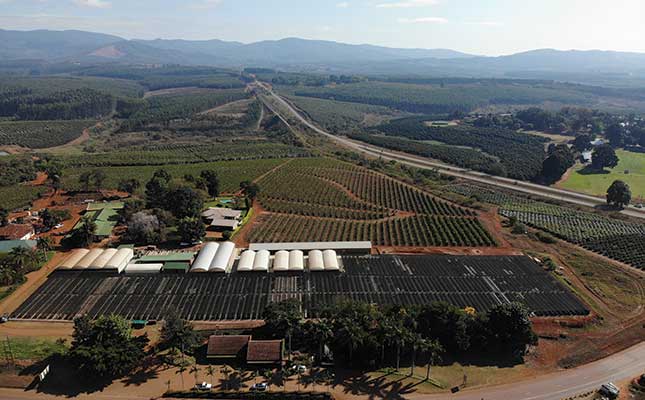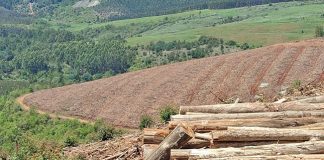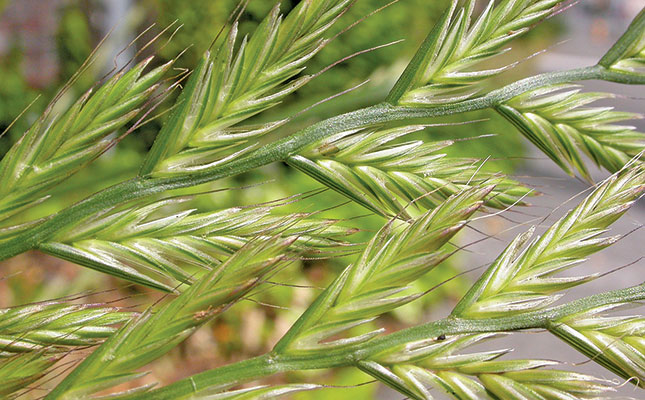
Photo: Supplied
The growing of trees from seedlings or clones is a crucial step in fruit production. The way in which trees are propagated, handled and managed in a nursery contributes not only to their survival rate after planting, but their subsequent growth performance and uniformity, which in turn affects fruit-bearing.
A number of nurseries in South Africa supply local and international avocado producers with trees. One of these is the Allesbeste Nursery situated in the picturesque Magoebaskloof area near Tzaneen in Limpopo.
The nursery was established in the 1980s by the late Dr André Ernst and is currently managed by Llewellyn van Zyl. Certified by the Avocado Nurserymen’s Association, the nursery is recognised for providing superior-quality avocado trees and currently holds an ANA five-star grading for its quality and hygiene standards.
According to Zander Ernst, director of marketing and production at Allesbeste, the avocado industry has identified a number of production pitfalls over the past couple of years that directly affect tree health and productivity.
“One of the important aspects, and which has major consequences, is how propagation practices affect root and tree health.
“Allesbeste Nursery aims to be the world leader in the production of high-quality avocado trees and a leader in the development of superior cultivars and rootstocks. We also strive to improve and develop the avocado industry globally in a responsible and sustainable manner. We supply top-quality clonal rootstock avocado trees for our own orchards, as well as to customers locally and internationally.”
Developing a cloning technique
Allesbeste is one of only two nurseries in the world that developed its own cloning technique, namely micro-cloning. Traditionally, avocado rootstocks are propagated by seed. In fact, many leading countries today still prefer this method of propagation, mainly because the available clonal propagation techniques are labour-intensive, arduous and, to a certain extent, uneconomical.
Beginning in the 1990s, the Allesbeste team developed and commercially implemented a micro-cloning technique. Derived from the so-called Frolich method, which is used by nurseries worldwide, Allesbeste’s approach involves positioning micro-containers over the etiolated shoots that develop from a ‘nurse graft’. The shoots are then grafted to a commercial scion cultivar and the fully developed clones later separated from the nurse seedling. A wholesale nursery then transplants the clones.
The technique cuts transport costs considerably, enabling trees to be exported at a reasonable price, and Allesbeste profitably delivers large numbers of micro-cloned trees to growers and nurseries worldwide. The technique has also enabled Allesbeste to set up local satellite nurseries in George, Pietermaritzburg and Mooketsi to increase its reach.
The details make the difference
Micro-cloning is a high-precision technique where every step has been optimised for success. To begin with, a nurse seed is planted in a long, narrow-sleeved polyethylene liner bag of 350mm x 100mm with a 1ℓ volume filled with sterile coco peat. The seedling is allowed to grow until the stem is thick enough (approximately 6mm in diameter) to be grafted.
As soon as the nurse seedling is ready, the desired clonal rootstock is grafted onto the seedling as close to the seed as is practical. This occurs approximately eight weeks after planting.
At bud burst, three to four weeks after grafting, the plant is placed in a well-ventilated etiolation room (a dark room) with a temperature of approximately 25°C. The buds develop in the dark and produce white (etiolated) shoots. Two shoots per graft are allowed to develop.
Approximately four weeks after bud burst, when the etiolated shoots have grown to between 200mm and 300mm long, the plants are removed from the room. Indole-butyric acid is then applied to a small incision made at the base of each etiolated shoot 100mm above the graft union. About 2g of a controlled release fertiliser is applied to the surface of each liner bag to support the growth process.
Wire holders are then inserted in the liner bags and bent to fit 55ml polyethylene micro-containers positioned over the etiolated shoots (one container over each shoot). After positioning, the containers are filled with sterile coco peat or any other suitable rooting medium.
The plants, of which only the upper parts of the etiolated shoots and leaves protrude from the containers, are placed under shade cloth to induce photosynthesis and to harden off progressively. Root initiation and shoot elongation progress during this stage.
As soon as the shoots have reached the right length, they are grafted no higher than 300mm above the micro-container to a commercial scion cultivar. The plants are moved to a greenhouse set at 28°C and 75% humidity.
After bud burst, and when the newly developed flushes are approximately 50mm in length, the fully developed avocado plants or micro-clones are separated from the nurse seedling just above the nurse graft and below the micro-container.
The micro-clones are then placed in specially designed trays and kept at about 85% relative humidity. A balanced fertiliser mixture is applied about one week after separation.
Approximately eight weeks after separation and just before commencement of the second flush, the micro-clones, now hardened off and with expanded leaves, are ready to be sold directly to distant growers or satellite nurseries. These grow the plants large enough to allow for transplantation in a field or to be sold as trees. The plants take three to four months in summer and six to eight months in winter to reach a saleable stage.
“In a nursery, seedlings are kept under ideal conditions. Hardening is necessary to make them strong enough to tolerate the harsh conditions of the planting site. This is generally done by reducing the amount of watering about a month before the date of planting,” explains Ernst.
If not sold during this stage, hardened-off micro-clones are transplanted to 7ℓ polyethylene plant bags (420mm x 150mm x 125mm) filled with coco peat.
Prior to selling or planting, the root system of each tree is inspected for quantity and quality, and any tree with diseased roots is discarded immediately. The plants are kept under 40% shade until ready to be sold commercially.
Advantages
Micro-cloning ensures rapid propagation, produces large numbers of healthy rooted plants, and does not destroy the nurse seed or graft. Importantly, the efficiency of the technique enables Allesbeste to manage production costs.
“We can produce clonal plants that are small, light, and comply with the highest phytosanitary standards of any country in the world,” says Ernst.
Countries to which trees have been exported include the Philippines, Mozambique, Kenya, Zambia, Senegal, Egypt, Tanzania and Zimbabwe. Smaller batches have also been exported to Ethiopia, Thailand, Lebanon, Spain and Morocco. NuTreeFarm Agricultural Company in India has partnered with Allesbeste and signed a licensing agreement to provide high-quality avocado plants to farmers in that country.
“We’re very focused on providing quality trees to our customers,” says Ernst. “When someone buys a tree from us, they can be 100% sure that the root system of each tree is a clone. The roots are inspected during various stages of propagation. This means that the grower can have a high level of confidence that all the transplanted trees will in fact establish. We look at size, height, leaf colour, and root development and health when we evaluate the trees.
“Trees sent to customers have to be uniform to allow the grower to optimise production and return on investment. Throughout our process, we therefore continually ensure that trees are uniform and according to specifications. We’d rather cull trees in the nursery than replace them once they reach the grower, or see growers establish sub-par orchards.”
He adds that nursery practices must be consistent and the various growth stages must be closely integrated and well managed.
“If any stage or aspect in the workflow is substandard, it will have a negative impact on the entire production process. Good-quality trees can’t be produced without care and tending.”
Allesbeste follows a stringent biosecurity protocol at the nursery, explains Ernst. “Most micro-organisms and pathogens that cause disease are transferred through contact with contaminated material. Keeping the nursery neat and clean reduces the chances of infection. Equipment is sterilised at frequent intervals, and dust and water run-off are managed carefully.”
Traceability
Traceability throughout the process is critical and is managed diligently by Van Zyl and
his staff. Each mother tree is mapped and indexed at every step of the process, and each resultant plant can be traced to the original mother plant. These labels enable the grower to identify and trace any plant in the orchard that deviates from the norm.
Allesbeste offers, amongst others, the three main commercial clonal rootstocks, namely Dusa, Bounty and Duke 7, grafted to the cultivar of choice. The main cultivars include Hass, Lamb Hass, Maluma, Pinkerton, Ryan and Fuerte.
“At Allesbeste, we’re intensely focused on research and the development of rootstocks and scion cultivars to produce uniform trees that are healthier and generate higher yields. We have a long-term commitment to invest in new material that offers higher productivity and disease tolerance than that seen in the current standard material. Recently, we tested 42 different rootstocks selected from local and international material.”
Mother tree identification and evaluation also remain important in providing quality trees and consistently improving the quality of trees supplied to growers.
“We’ve dedicated orchards to planting and evaluating various mother trees. We carry out visual inspections as well as constant indexing and data analysis of several mother blocks. It’s important that these trees are healthy, with no visible signs of disease.”
Ernst stresses that a close relationship between grower and nursery is essential, and expects to see more of this co-operation over the next decade, in part due to new varieties, cultivars and rootstocks.
“Growers are becoming more specific regarding cultivar and rootstock combinations than in the past. It’s crucial that there’s a good interaction in this regard so that nurseries know what variety-rootstock combinations to prepare.“
Email Llewellyn van Zyl at [email protected].










